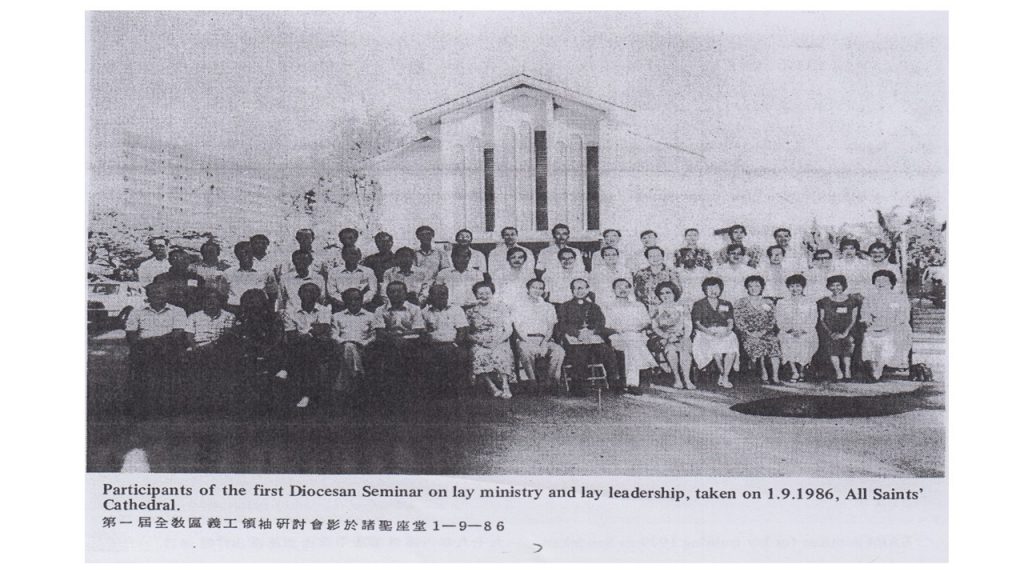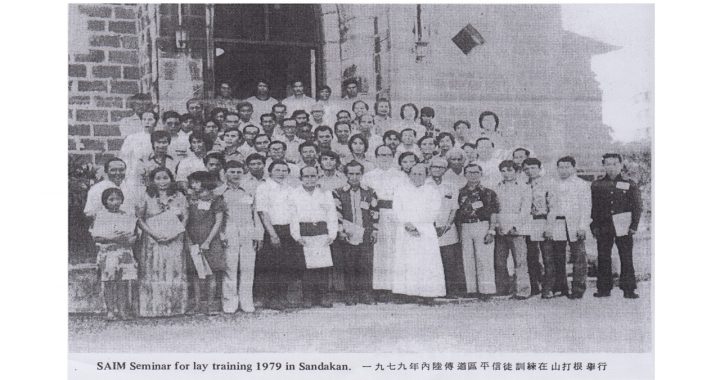Very Rev Yong Chen Fah
I. Introduction
When our Lord had ascended into His Glory, the Father sent His Holy Spirit and gave spiritual gifts to His Church ‘to equip God’s people for work in his service, to the building up of the Body of Christ’ (Ephesians 4:12). So, the Anglican Diocese of Sabah is no exception. The Church in Sabah came into existence by God’s will, and God will equip the whole Church to witness and share its life in the Christian Community and in the community at large.
II. How and when it begins?
Lay Training in the Sabah Diocese dated back to the early 60s. It started at St. Patrick’s Church, Tawau, when Canon Walter Newmarch called a small group of people every Wednesday night to come together for Bible study and discipleship training. This work of lay training continued until late 60s.
However, the P.I.M. Consultation held in Hong Kong in 1974 gave the impetus for lay training in the Diocese of Sabah. It was in this P.I.M. Consultation that the whole Anglican ministry in this Region which was very much clergy centered was called into question. As a result of this Consultation, lay training appeared as a budgeted item for the first time, and the P.I.M. Consultation considered this as priority item which was proposed by Sabah Diocese. Consequently, US$6,000 per annum for the next three years was given to Sabah Diocese to conduct lay training. In the 1984 P.I.M. Consultation in Kuching, the whole Consultation increased this to US$10,000 per annum for the years 1985-1987 in order to support the work of lay training in the Diocese of Sabah, which includes the training of the laity in the interior church leaders.
III. Lay Training: How it’s carried out?
From 1975-1981, Lay Training in the Diocese of Sabah was carried out at the local areas (a) Town Churches; (b) Interior Churches.
(a) Town Churches: Kota Kinabalu, Sandakan and Tawau were regarded as the three main centers to carry out lay training for the town Churches by inviting outside lecturers to conduct lay training in Old Testament, New Testament, Church History and Christian Ethics and Doctrine. These three main centers were also given financial assistance to build up a small library. While this was being carried out, Sandakan, Kota Kinabalu also conducted at the local level some lay training at a more formal level through the Australian College of Theology, while Labuan conducted lay training on the Bethel Bible Course. Some candidates actually did the Certificate Course examination.
(b) Interior Churches: Lay Training in the interior Churches took the form of Church Leaders’ Seminar, and Form 5 & 6 students training course since 1979. The first Church Leaders’ Seminar was held in 1979 in St. Michael’s and All Angels’ Church, Sandakan, while the second one was held in 1981 in Tongod. Since then every year a seminar was conducted for the Church Leaders in the interior. As this was going on, an idea to conduct lay training for the Form 5 & 6 students for two weeks came into being, and was implemented since 1980. These students were trained for leadership and evangelism in the interior. As a result of this lay training ministry work for a few years, the Diocese begins to see young men and women from the interior churches responding to the ordained and non-ordained ministry.
Both the Church leaders’ Seminar and Form 5 & 6 lay training ministry prompted the Diocese with the idea of establishing a Bible School for the training of Catechists. Hence, this gave birth to the Tongod Bible School in 1981 when P.I.M. Consultation allocated as top priority more than R$150,000 for this project. Today, due to changing needs, this Bible School becomes the Anglican Christian Education Centre with Miss Sylvia Jeanes as its Director conducting lay training mostly for the interior churches. However, she did a lot of Sunday school teachers training in the town churches as well.
IV. Lay Training: A New Emphasis
In 1982, the Diocese entered into a sister relationship with the Diocese of Singapore. The first joint effort was the joint Diocesan Lay Training Consultation held in Singapore. From then on, the two Dioceses continue this joint consultation on lay training every year.
As a result of several years’ joint consultation, the two Dioceses had been able to work out 3 years lay training courses for the two Dioceses leading to the training of Lay Readers and non-stipendiary priests. However, the first year course emphasizes on ‘How to do some practical ministry’, while the second year on ‘Getting to know your Bible’, and the third year on more specific training for specific ministry for church leaders, Lay Readers and non-stipendiary priests.
As a result of the joint lay training consultation in Singapore in January 1987, the two Dioceses jointly sponsored a three weeks intensive lay training courses on Preaching, Church Planting and Elements of Anglicanism to be held at All Saints’ Cathedral from 10-30 August, 1987. For the Singapore Diocese, it aims to train the lay people to do short term church planting in Thailand, while for Sabah Diocese it aims for the training of lay preachers and interior outreach. This training will be conducted in English, but we hope that it will be offered in Chinese and Bahasa Malaysia in the future.
V. Lay Training: the key to total ministry
At the 13th Diocesan Council Meeting held at Bishop Koh Memorial Conference Room at All Saints’ Cathedral, Kota Kinabalu from 15-17th September 1985, a resolution reads as follows:-
“That owing to the shortage of manpower, this Diocesan Council examines and evaluates the functions of the laity in the total ministry of the Church, and requests the ordained ministers of the Diocese to consciously and untiringly encourage, educate and lead and train the lay people in each locality to share in the total ministry of the Church at the local level’’.
So, the Diocesan Lay Training Committee and the Diocesan Rural Lay Training Committee were asked to look into the whole matter and report to the next Diocesan Council Meeting in 1987. These two lay training committees were appointed by the Diocesan Standing Committee in early 1984 to promote lay training and co-ordinate lay training in the Diocese. Now, the Diocesan Lay Training Committee has major proposals to the 14th Diocesan Council. If all these proposals were to be accepted and implemented, it will give further impetus to lay training and lay ministry. The Diocese, then will move towards the total ministry of the Church: ordained, non-ordained full-time, and non-fulltime lay ministry.
VI. Retrospective
Within such a short history of lay training in the Diocese, what has it done to make the Diocese what it is today?
First of all, the spiritual level of the Diocese both in the towns and in the interior has increased. This is seen in the overall giving, and lay participation in the Diocese.
Secondly, through the lay training programmes in the Diocese, some young people from the interior had gone forth to be trained for the ordained and non-ordained ministry.
Thirdly, lay leadership at the Diocesan level as well as at the Parish level had played a significant role in the ongoing ministry of the Churches in all the districts. This is seen in the lay leadership in Bible Study groups, and lay people involving in the ongoing ministry of the churches.
Fourthly, lay training has given the enabling to the lay people to be able to participate at the Partners-In-Mission Consultation e.g. Dr. K.K. Khoo and Mr. Peter Pang at the U.S.A. and Southwell Consultation respectively.
Fifthly, lay training has enabled lay people to take up local leadership in the role of Lay Readers as well as other lay participation.
With the move to further develop lay training, the years ahead are very promising for the whole Church. We pray that this will bring about a balanced ministry in the whole Church, that is, lay and clergy, full-time and non-fulltime will have its role to fulfill so that the whole Church will grow spiritually and numerically for the glory of Christ.



